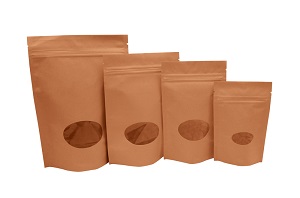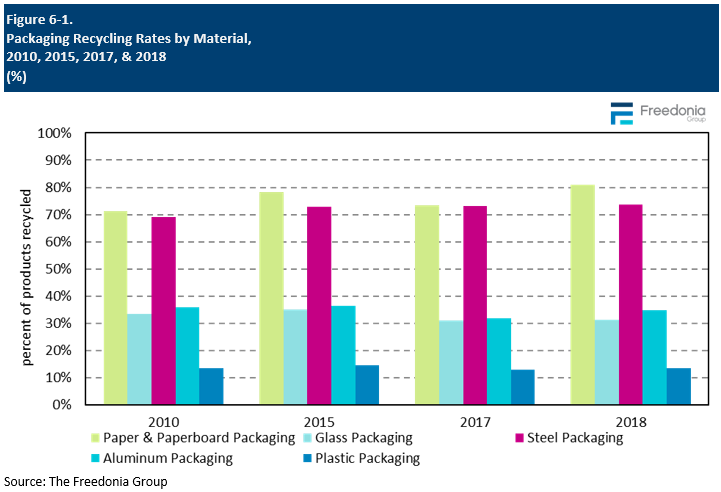Report Overview

Learn more about sustainability in the packaging industry with these new spotlight chapters:
-
foodservice packaging
-
bioplastics
-
clamshells
This study is focused on identifying key trends in sustainability in the packaging industry. Sustainability trends are analyzed by leading packaging material (plastic, paper, metal, glass, molded fiber) and in terms of packaging producer and end user sustainability goals. Historical data and forecasts for overall packaging demand and key market segments (food, beverage, pharmaceuticals, foodservice disposables, and other markets including e-commerce) are also provided. Additionally, profiles of select packaging products, markets, and materials are highlighted. Consumer survey data related to packaging sustainability collected by The Freedonia Group are also presented.
Featuring 37 tables and 29 figures – available in Excel and Powerpoint! Learn More
Read the discussion regarding Sustainability factors
Ongoing sustainability efforts continue to significantly impact the US packaging industry. Driven – at least in part – by public pressure, packaging producers and end users are increasingly concerned about the environmental effects of their products. This has sparked a variety of key trends and targets in the packaging industry, such as source reduction, improved recycling rates (especially for plastics) and the increased use of biodegradable and/or compostable materials.
Rising Concerns Surrounding Impending Sustainability Targets
Over the past decade, several major companies in the packaging industry have set sustainability-oriented goals; some of their deadlines come as early as 2025. Reducing the amount of virgin plastics and improving overall packaging efficiency are among the most prominent objectives. However, concerns regarding the feasibility of those timetables have grown. For example, despite significant progress in recent years, the Ellen MacArthur Foundation recently cast doubt on its major plastic reduction goals by indicating that most participating companies will not meet them. To achieve these sustainability targets, many packaging producers will have to accelerate their efforts or face potential consumer and regulatory backlash.
Paper & Plastic Continue to Dominate Packaging but See Growing Competition
Paper and conventional plastics have long been the preferred materials for the vast majority of packaging products due to their versatility, performance, and low cost. These materials have proven their efficacy across wide ranges of packaging markets and formats. They will continue to see high usage, but also face increasing competition from alternative materials – such as bioplastics and molded fiber – that are viewed as having stronger environmental profiles. Conventional plastic will be hampered by its contribution to problems with pollution and its reliance on unsustainable fossil fuels. Furthermore, wider implementation of reusable packaging will pose a threat to traditional single-use paper and plastic packaging.
Recent Price Inflation Impacts Sustainability Efforts
Recent increases in the price of raw materials have coupled with lingering supply chain and labor availability issues to push the price of many packaging products to record highs. As a result, some end users have switched back to less expensive conventional materials with better availability. However, high material costs have also accelerated efforts like thin walling and the reduction of unnecessary secondary packaging, which reduce the overall volume of packaging material used.
Thus price inflation has, from a sustainability perspective, had both positive and negative effects on the packaging market. While many eco-friendly packaging materials – such as bioplastics – are even more expensive than traditional ones (and therefore pose additional challenges to end users who wish to incorporate them into packaging lines), efforts to reduce the amount of unnecessary packaging have helped companies both save money and reduce waste. While prices are expected to moderate going forward, they are expected to remain above historical norms for many materials.
Changing Package Size Preferences
Trends toward smaller single-serving/unit dose packages, family-size or bulk units, and multipacks are having an important impact on packaging sales, driving product manufacturers to revamp packaging to meet changing consumer needs. For example:
- A switch to smaller sizes can result in more intensive use of packaging overall, with more packaging per unit of goods contained.
- For multipacks of products, additional secondary/protective packaging is sometimes necessary, which also boosts packaging demand.
- In contrast, economy- or family-size products are generally less intensive users of packaging, and a shift toward bulk sizes can reduce packaging consumption.
While particularly pronounced in the food market due to increased consumer demand for products that support portion control and are convenient to consume, trends toward smaller, single-use packages are expanding in a range of consumer product markets, as well, such as household and personal care items, lawn and garden consumables, and replacement products for water treatment systems. However, this trend will be somewhat offset by increased sales through club stores which promote large economy-sized consumer products.
Reducing packaging size can promote sustainability by reducing product waste. This is of particular concern in the food market. For instance, due to consumer complaints about product spoiling before it can be used, food companies are shifting to smaller packaging sizes to accommodate smaller portions that are more likely to be consumed quickly.
Shelf Appeal
Packaging is a key aspect of shelf appeal, as the packaging is often the first interaction consumers will have with the product. Shelf appeal is generally defined as the attractiveness of a product on a store shelf, which can affect consumer purchasing decisions. Packaging can affect a product’s shelf appeal in several ways. For instance, use of eye-catching graphics and text relaying information about the product and/or the company can help brands differentiate themselves from the competition.
The type of packaging and its material composition are key elements of shelf appeal.
- Use of stand-up pouches is growing in a range of markets – from food and beverage to personal care products – in part due to the distinct look of pouches compared to traditional packaging formats in many applications.
- Luxury brands often employ glass packaging, despite its higher cost and heavier weight, because of its high aesthetic value, which supports the premium image of the product.
- Use of higher-cost sustainable packaging can have a similar premiumization effect particularly with consumers who are willing to spend more on products that they perceive to be eco-friendly. Additionally, companies may use packaging to promote the sustainability of the packaged product and other corporate sustainability efforts.
Attitudes About Recycling & Biodegradability
How consumers value recyclability and biodegradability plays a key role in how they view plastic packaging. More than half of respondents (60%) noted that plastics that are recyclable are eco-friendly. This view is most common among middle aged consumers (70% of them agreed), urban dwellers (68% agreed), and higher income consumers.
While more than half of the consumers surveyed believed that only biodegradable materials are eco-friendly, there is significant overlap with consumers who agree that recyclable plastics are eco-friendly. For instance, at least two-thirds of urban dwellers and higher income consumers agree with both statements. Many consumers remain unsure about what ultimately constitutes eco-friendly packaging. As such, a compelling story and additional education can help consumers view sustainability more broadly and encompass materials – such as conventional plastics – that they would generally be unlikely to consider ecofriendly.
Packaging Material Sustainability Comparison
In terms of sustainability, packaging materials compete on a variety of factors, including:
- weight, as this affects the fuel economy of distribution
- recyclability
- use of recycled content
- biodegradability
- compostability
- reusability
- use of renewable resources versus nonrenewable resources
- resource and waste reduction – including the ability of food packaging to reduce food waste
While some materials have more than one of these attributes, no one material possesses all of them. Furthermore, cost and performance considerations limit the viability of certain materials in certain applications. For instance, though molded pulp is commonly used to package egg and fresh produce and in shipping containers for its cushioning abilities, its poor moisture properties have precluded it from more demanding applications until recent developments in new production technology. However, cost and lack of shelf appeal remain limiting factors.
Paper is seeing greater usage in a range of food and nonfood packaging applications due to its perceived sustainability attributes, which include:
- high recycling rates
- high usage of recycled content
- biodegradability (when uncoated or treated with biodegradable coatings)
- use of renewable resources (e.g., wood pulp)
Molded wood pulp is used in applications such as meat, poultry, and seafood, fresh produce and egg packaging. However, concerns over deforestation to make wood-based products are providing opportunities for other biodegradable materials based on more easily renewable resources, such as bamboo and sugarcane.
Despite concerns about the environmental impact of plastics, these materials can still offer certain sustainability advantages over other materials. For instance, plastic often remains a good choice in food packaging applications because its superior barrier properties can prolong shelf life and thereby reduce food waste.
